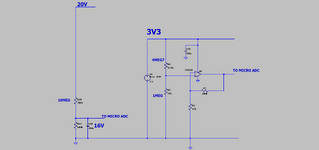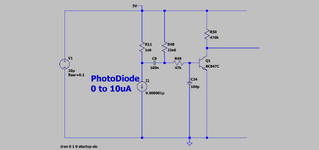cupoftea
Advanced Member level 6

Hi,
We have circuits with multiple MegOhm resistors in them. Rails are mostly 3V3 and 5V.
Resistors are as high as 22MEGs in places.
If probing the attached with say a scope probe, would you recommend a 100:1 probe?
Also , please confirm that the "22MEG" circuit is useless?......i cant see any property of a photodiode that could ever help the collector of the NPN to ever go high?
Must admit that 22MEG resistor does look like an "elephant in the room" to me though?
(LTspice of "22MEG" circuit also attached)
We have circuits with multiple MegOhm resistors in them. Rails are mostly 3V3 and 5V.
Resistors are as high as 22MEGs in places.
If probing the attached with say a scope probe, would you recommend a 100:1 probe?
Also , please confirm that the "22MEG" circuit is useless?......i cant see any property of a photodiode that could ever help the collector of the NPN to ever go high?
Must admit that 22MEG resistor does look like an "elephant in the room" to me though?
(LTspice of "22MEG" circuit also attached)
Attachments
Last edited:




